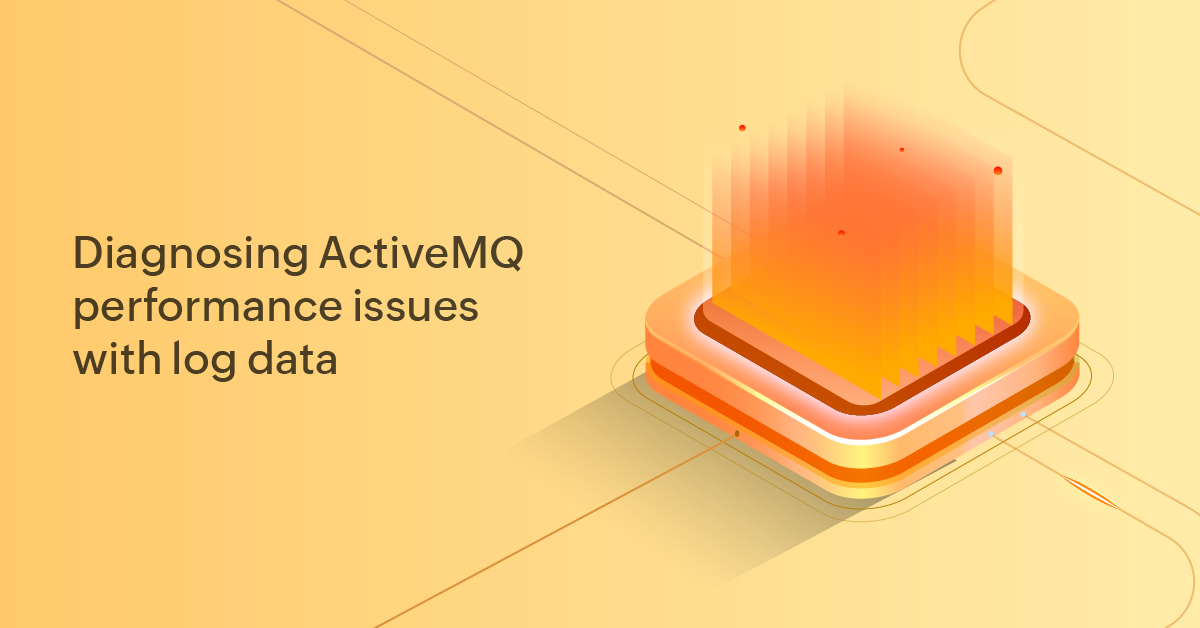Diagnosing ActiveMQ broker performance issues with log analysis

Apache ActiveMQ is a widely used message broker that enables seamless communication between distributed applications. However, as the volume of messages increases, performance bottlenecks can arise, leading to slow message processing, high latency, broker crashes, and out of memory (OOM) errors.
One of the most critical issues affecting ActiveMQ is OOM errors, which occur when the broker exceeds its allocated heap memory. This can result in service failures, message loss, and prolonged downtime.
So, how do you detect and prevent these issues before they escalate? Log analysis is the key. By monitoring ActiveMQ logs, administrators can identify early warning signs of memory exhaustion, troubleshoot issues in real time, and ensure that the broker operates smoothly.
In this blog, we’ll focus on OOM errors and using log analysis to diagnose and resolve them efficiently. We’ll also explore how Site24x7's log monitoring and plugins provide real-time visibility into broker performance.
How log analysis helps in diagnosing OOM errors in ActiveMQ
ActiveMQ logs provide valuable insights into broker operations, memory usage, and system health. By analyzing these logs, administrators can:
- Identify memory warnings before a crash occurs.
- Pinpoint the cause of excessive memory usage.
- Correlate OOM errors with specific queues, topics, or message patterns.
- Take preventive actions to optimize broker performance.
A real-world use case: Detecting an OOM error in ActiveMQ logs
Example of a log entry indicating an OOM error
2024-01-29 10:45:12,678 | ERROR | java.lang.OutOfMemoryError: Java heap space | org.apache.activemq.broker.BrokerService | ActiveMQ Broker
What this log means
- The log level (ERROR): This indicates a critical broker failure.
- The message (java.lang.OutOfMemoryError: Java heap space): This confirms that ActiveMQ has exhausted its allocated memory.
- The component (org.apache.activemq.broker.BrokerService): This identifies that the broker service is impacted.
- The impact: The broker may crash, causing message delivery failures and potential data loss.
Common causes of OOM errors in ActiveMQ
1. Large message backlogs
- If messages are not being consumed fast enough, they accumulate in memory.
- Slow consumers or missing consumers can lead to excessive memory usage.
2. Improper memory configuration
- The heap size (the -Xmx and -Xms Java virtual machine (JVM) options) may be too low.
- The broker's memory limits (memoryLimit, storeLimit, and tempLimit) may be misconfigured.
3. Persistent messages without adequate disk space
- If messages are persistent but the disk store fills up, the broker may hold them in memory.
- The misconfiguration of KahaDB, Java Database Connectivity, or other persistence stores can lead to memory issues.
4. A large message size
- ActiveMQ holds large messages in memory before dispatching them.
- If large messages are not streamed properly, they can overwhelm memory.
5. Unacknowledged messages
- If consumers do not acknowledge messages, ActiveMQ may keep them in memory.
- Redelivery attempts increase memory pressure.
How to diagnose and resolve OOM errors
Step 1: Monitor ActiveMQ logs for memory warnings
Before an OOM crash, ActiveMQ often generates WARN logs indicating high memory usage.
Example of a warning log
2024-01-29 10:30:00,123 | WARN | Memory usage exceeded threshold: 90% | org.apache.activemq.usage.MemoryUsage | ActiveMQ Broker
Action
Set up automated alerts for such warnings using a log monitoring tool to detect and address memory issues proactively.
Step 2: Check the Java heap size and adjust the memory limits
Modify the ActiveMQ startup script to allocate more memory to the broker.
Example configuration (activemq.sh)
export ACTIVEMQ_OPTS_MEMORY="-Xms2g -Xmx4g"
Action
Increase the heap size based on the traffic patterns and memory requirements.
Step 3: Enable persistent messaging to reduce the in-memory load
Storing messages on the disk instead of keeping them in memory helps prevent OOM errors.
Example configuration (activemq.xml)
<persistenceAdapter>
<kahaDB directory="activemq-data/kahadb" journalMaxFileLength="32mb" cleanupInterval="5000"/>
</persistenceAdapter>
Action
Enable persistent storage to offload messages from memory.
Step 4: Set memory limits on queues to avoid overloading
Limit the memory usage per queue to prevent excessive message accumulation.
Example configuration (activemq.xml)
<policyEntry queue=">" producerFlowControl="true" memoryLimit="50mb"/>
Action
Configure memory limits per queue to prevent broker overload.
Step 5: Optimize garbage collection to prevent memory fragmentation
Frequent garbage collection (GC) pauses can lead to memory exhaustion. Monitor GC activity using JVM logs.
Example of a JVM GC log monitoring command
-XX:+PrintGCDetails -XX:+PrintGCTimeStamps
Action
Tune your GC settings based on memory consumption patterns.
Step 6: Use Site24x7's log monitoring and plugins for proactive monitoring
Manual log analysis can be time-consuming. Site24x7's log monitoring provides real-time visibility into:
- Memory usage trends to detect early signs of OOM errors.
- Automated alerts when memory usage crosses critical thresholds.
Key features of Site24x7's log monitoring and plugins
- Centralized log collection and analysis
- Preconfigured dashboards for memory and performance metrics
- Custom alerts for OOM errors, slow message processing, and broker failures
- A seamless integration with ActiveMQ for real-time issue detection
Action
Set up Site24x7's ActiveMQ log analysis and plugins for continuous monitoring and proactive issue resolution.
Diagnosing ActiveMQ broker performance issues requires effective log management and analysis. By proactively monitoring ActiveMQ logs, you can prevent costly outages and ensure smooth message broker performance.
Comments (0)